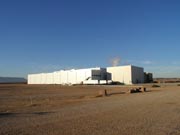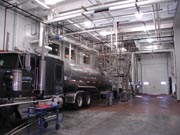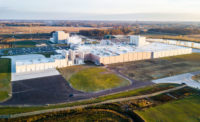
"There aren't a lot of bells and whistles," Broadhead says as he makes his way around the plant.
There is some factual basis to Broadhead's comment about the plant location. St. George wasn't chosen for the scenery and the mild climate, but a west-of-the-Rockies location was key to Wells' efforts to strengthen its presence in the western states. The new location cuts distribution times and distances by more than 50% to most west-coast markets.
"We are expanding westward," says Doug Wells, president of Wells' supply group. "To be a top national brand in the next few years, we know, based on population trends, that we need to have the capability to reach all the way to the coast with our retail grocery products and continue to grow our current western markets like Arizona, New Mexico, Colorado, and Utah. St. George has a great transportation infrastructure and is geographically located to minimize transportation costs and maximize access to western markets. It's located within eight hours of nearly every major west coast city. That means a much higher level of service to our customers in the west."

Starting up
Wells' began construction on the plant in June of 2002 on a 50-acre site in the newly developed Fort Pierce Industrial Park. The 160,000 sq ft plant was completed in June of last year.We did the startup in phases," Broadhead said. "Ecolab engineered our CIP systems, so we worked with them on testing the system.
"We tested it with water first, to make sure everything was flowing correctly. You've got to know that you can clean it before you can start to make ice cream."
Phase two was to test with ice cream.
"We brought in mix and tested the freezers first and then went to the fillers," Broadhead said. By the end of July the plant's two lines were running ice cream for distribution.
The plant is laid out in a linear fashion, with raw milk intake at one end and load out docks at the opposite end.
The receiving bay is fully enclosed to protect it from the dust that is often carried by the desert winds. Two tanker trucks can be pumped out simultaneously. There are eight, 6,000-gal raw tanks for milk and cream, and three fiberglass sugar tanks. Milk is procured primarily from Utah dairy farms.
Batch controls work off a database of recipes and calculate raw ingredient differentials to formulate batches. Liquid ingredients are automatically mixed in one of the three batch tanks. Dry ingredients are added manually.
"It does all the calculations based on what we have in our tanks," Broadhead says. "A bell tells the batch operator when to mix the batch."
High speed mixers are used to blend the batch before pasteurization. The base is pasteurized to 180 degrees then cooled to 35° F with an APV pasteurizer, before being sent to one of eight pasteurized storage tanks.
"We keep the raw side completely segregated from the pasteurized side," Broadhead says, as he enters a large room where the pasteurization tanks are lined up against a far wall.
There's lots of extra space in this room, as there is throughout the plant. It's indicative of the St. George plant being brand new. There's plenty of room to work, and plenty of room to grow.
In addition to standard top quality sanitation-minded materials such as acid brick, tile walls and stainless steel, the plant has some of the newer features that you usually don't find in a 20- or 30-year-old plant.
Horizontal piping, electrical and other utilities are tucked away in a drop ceiling which keeps them out of the processing and filling rooms and makes those rooms easier to clean. And a hepafiltrated, positive airflow system is used to keep contaminants out of filling rooms.

Good things come in big packages
There are currently two lines running at the Utah plant, and both are set up for medium to large package sizes. During Dairy Foods' visit in November, the plant was running half-gallon squares and 5-quart pails. The equipment can also accommodate round half-gallon containers. Two three-barrel freezer systems, a WCB and a Hoyer, are used for the two lines. Two Anderson fillers and one Burghoff are used depending on the packaging sizes. Standard WCB fruit feeders are used for fruit and inclusions. The plant is designed to run 18 million gals a year.After filling, the packages go through a check-weigher and metal detector and are then bundled and wrapped with a Hagemann wrapper. The half-gallons are put in bundles of four, the 5-quarts in pairs.
A conveyor takes the bundles up one floor and into the VRT. The 60-ft high freezer, manufactured by Intec USA of Durham, N.C., has a total capacity equal to about 150 pallets of ice cream. Currently, Wells' is running it at about half-capacity. A second-floor control room overlooks the cavernous freezer and the operator monitors the operations via computer screens, while communicating with the production and palletizing rooms.
The freezer runs at about -39°F, with the equivalent of 40-50 mph wind. The ice cream is generally in the room for about four hours, but there is some variation depending on the package size.
Once the product is hardened it is ready to be palletized. In November, palletizing was being done by hand, but plans called for the addition of an automated palletizer.
A 35,000 sq-ft cold storage warehouse can handle up to 3,000 pallets. Products manufactured in Le Mars are brought in so that full loads can be shipped to western customers.

At home in St. George
When Wells' Dairy began its site search for a western plant, it had a number of criteria the site would need to meet. A good labor force was important, as were reliable affordable utilities, and of course proximity to major interstate corridors. St. George offered all of these. The resort community, which is also home of Dixie State College, is located in Utah's southwest corner. St. George has access to Interstate 15 which arcs across the southwest states connecting Los Angeles, Las Vegas and Salt Lake City, and intersecting with the I-70 and I-80 east-west corridors. From Salt Lake City, other interstates fan out to the northwestern states.Of the 49 employees at the St. George plant, a dozen transferred from other Wells' facilities. Wells' officials say those employees hired locally have proven to be well-educated with a good work ethic.
The local economic development organization was thrilled to have Wells' locate as the first tenant in the new industrial park. St. George provides water, and Wells' constructed its own waste water treatment lagoon on the plant site.
The climate is mild enough for year-round golf, and the flora and fauna is distinctly desert.
"It takes a while to get used to the hot weather in the summer, and the scorpions, rattlesnakes and tarantulas," Broadhead says. He keeps a terrarium with some of these fearsome critters in his office.
Now they have some company in the form of a Blue Bunny from Iowa.
Wells' Dairy, St. George, Utah Vendors
Variable Retention
Time Freezer:
Intec USA, Durham, N.C.
www.intecvrt.com
919/433-0131
Heat Exchangers/Process Equipment:
Invensys/APV
800/554-5290
In-line Freezers:
WCB Ice Cream
www.wcbicecream.com
215/425-4320
Tetra Pak Hoyer
www.tetrapakprocessing.com
262/249-7400
CIP Systems:
Ecolab
www.ecolab.com
800/392-3392
Packaging:
Huhtamaki
www.huhtamaki.com
800/355-4243
Berry Plastics
www.berryplastics.com
812/424-2904
Plant Facts
Location: St. George, UtahPlant Size: 160,000 sq ft
Site: 50 acres
Products: Ice cream
Production: 18 million gals annually
Plant mgr: Paul Broadhead
Plant employees: 49
